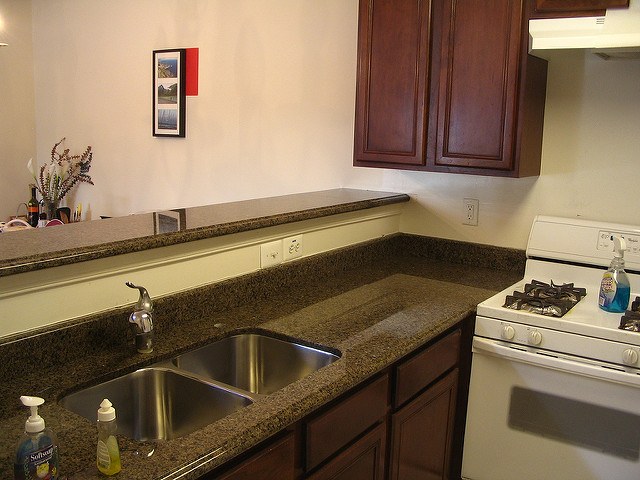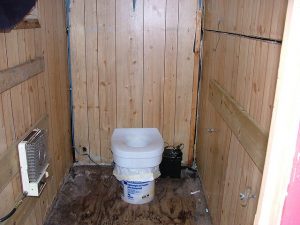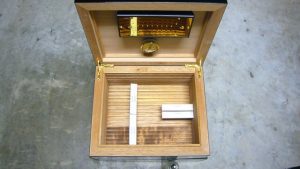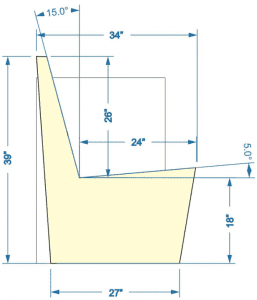Kitchen countertops are one of those projects that even seasoned do-it-yourselfers often shy away from, instead hiring someone to do it for them. But they really aren’t hard to do at all. The only thing that can be considered difficult about countertops is that you have to be careful when working with laminate or it can break.
Granted, laminate isn’t the only material kitchen countertops are made of, countertops can be covered with ceramic tile, made of Corian, or out of one of the more exotic materials, like marble or granite. Nevertheless, laminate countertops are still the most common type out there, due to their lower cost and ready availability.
You can even buy pre-made laminate countertops, where the laminate is already attached to the substrate. Countertops of this type generally have a built-in backsplash, and are easily identified by the curved fillet between the countertop and the backsplash. The front corner and the top of the backsplash are also usually curved, although they can be done in a variety of styles.
Before starting, you need to decide what you want your finished countertop to look like. Since we’re working under the assumption that you’re making your own laminate countertop, this mostly refers to the edge material. The edge can either be covered with laminate or with hardwood.

Measuring and Building the Countertop Substrate
The countertop substrate for a DIY laminate counter should be made of ¾” thick MDF (medium-density fiberboard). This provides you with a uniform product to work with, without voids, and which will have a very smooth surface. That smooth surface is important for attaching the laminate.
When measuring and cutting a laminate countertop, figure on having the countertop overhand the front edge of the cabinets by one inch. If you have any exposed ends, which do not abut appliances, you may decide to allow your countertop to overlap the edge as well, either by one inch, like the front, or by as much as six inches. If you are going to go beyond six inches, you should provide that overhang with some sort of support, such as ornamental iron shelf brackets or wood shelf brackets.
Cut the MDF with a circular saw, table saw or jigsaw, whichever you have available. Push stick might help at this step. It is important that the edges are extremely straight and accurate. So if you have trouble cutting straight with the saw you are using, it is best to cut is slightly oversize and then smooth it out with a handheld belt sander.
The edge of the countertop needs to be 1-1/2” thick, even though the material is ¾” thick. This is accomplished by using a double thickness around the edge. Turn the cut countertop upside-down and attach strips of MDF all the way around the edges, starting with the front edge, then attaching the sides and finally the back edge. It is best if there is no seam on the front edge.
These strips are normally attached to the countertop with wood glue and 1-1/4” drywall screws, going through from the underside (the strip side). Be careful not to overdrive the screws into the material, allowing the point of the screws penetrate through the top surface of the countertop substrate. It is also important to ensure that they are attached exactly flush with the outer edge of the countertop substrate.
If your countertops need to be larger than you can cut out of a standard 4’x 8’ sheet of MDF, you’ll need to splice sheets together. In order to do this, cut a piece of scrap MDF to use as a splice, underneath the countertop. It should run the full length of the seam, less the space taken up by the spacer strips around the edges.
Once the countertop substrate is assembled, turn it over and sand the edges to ensure that the seam between the top and bottom pieces is perfectly smooth and even. Likewise, you should sand the top surface, to even up any seams between pieces of the countertop.
A good trick to ensure that you succeed in sanding these seams perfectly smooth is to mark several lines across the seam with a carpenter’s pencil. When you are sanding, check to see that the marks disappear on both sides of the seam. If it has disappeared on one side, but not the other, then the side it has disappeared on is high and needs more sanding, until the mark on the other side disappears.
Building the Substrate for a Hardwood-Edged Laminate Countertop
If you have chosen to make a hardwood-edged laminate countertop, you will need to incorporate the hardwood edge into the substrate, as you build it. This is generally made out of hardwood 1”x 2”s, which actually measure ¾” x 1-1/2”.
This means that the countertop should only be cut with a ¼” overhang over the fronts of the cabinets, rather than a 1” overhang. The MDF spacer strip is attached to the underside of the countertop as mentioned above. Once this is attached, the hardwood edge strip is attached to both pieces with glue and finish nails.
Apply stain (if it is being used) and varnish to the hardwood edge before gluing the laminate onto the countertop. Otherwise, any adhesive that gets on the edge can cause spots in the finish. It can be useful to stain and apply a coat of varnish before attaching the edge to the substrate, saving time.
Mounting the Countertop
The countertop is attached to the top of the cabinets with 1-5/8” drywall screws, coming up from below, through the corner pieces attached to the cabinets and into the bottom of the countertop. Be sure to push the countertop back into the wall, before attaching it.
With the countertop in place, the backsplash is added. This is usually a single thickness of ¾” thick MDF, 4” tall. It is attached to the wall with finishing nails. As with the countertop itself, make sure that any seams between different pieces of the backsplash substrate sit flush with one another. If a sink opening is needed in the countertop, it should be cut out at this time and the edges of the hole should be smoothed.
Installing the Laminate
Laminate is fragile, so must be treated with care. It can break easily, either when moving it or when cutting it. Broken laminate can be repaired with a filler made by the manufacturer, but the crack will always be visible, even after filling it.
Countertop laminate can be cut on a table saw, with a circular saw, with a jigsaw that has a very fine blade (hack saw blade, not wood cutting blade), with a laminate stripper, laminate shears or tin snips.
To start, the edges should be cut and installed. Always work your way from the harder parts to the easier parts. So, the first thing to do on most countertops is the backsplash. While we will want to cut and install the laminate on the backsplash first, keep in mind your material needs for the entire project, so that you don’t leave yourself without a big enough piece for cutting out the main part of the cabinet.
Laminate is cut slightly oversize (1/2” for edges and 1”-2” for tops) and then trimmed once it is installed. Always support laminate when cutting, to help prevent breakage. So, if you are cutting it with a circular saw, place two 2”x 4”s on the workbench or floor, with the cut line between them. That way, both sides of the cut are supported. Only use sharp blades when cutting laminate and only cut from the top side.
You’ll want to install your pieces in the following order:
- Top of backsplash
- Backsplash
- Side edges
- Front edge (unless you are doing a hardwood edge)
- Top
The top edge of the backsplash is unique, in that it is butting up against the wall, which probably won’t be perfectly even. So cut the strip of laminate to be used for the top of the backsplash and lay it on top of the backsplash, butted up against the wall. Holding it there, mark the full length of the strip with a permanent marker that is a good contrast with the laminate color. This will provide a line to trim the material, ensuring that it will butt up flush against the wall the entire length.
Gluing and Trimming Laminate
Countertop laminate is glued to the substrate with contact cement. It is called this, because it bonds on contact. This means you only get one chance to get it right. You have to locate each piece perfectly and place it where it goes the first time. Otherwise, you will end up having to break the laminate, trying to remove it.
The adhesive can be applied to the back of the laminate and to the substrate with a brush, paint roller or spreader. You can use a scrap piece of laminate, with a straight edge, as a spreader. You will want to apply two coats to the MDF substrate, as the first coat will soak in. the laminate itself only needs one coat.
Allow the adhesive to dry until it is tacky, before attaching the laminate to the substrate. It is useful to put spacers down on the substrate, to hold the laminate off of the substrate while you are positioning it. You can use dowel rods for this, or scrap strips of laminate. Neither will stick to the tacky adhesive.
With the spacers in place, lay the laminate on the countertop, adjusting it into position. Working from the center out, remove the spacers, one at a time, pressing the laminate down onto the countertop. One the entire piece of laminate is attached, go back over it again with a hard rubber roller or a pad of cloth, rubbing it down to ensure good contact and adhesion throughout the piece.
Trimming Laminate
Each piece of laminate needs to be trimmed as it is installed and before the next piece can be installed. This is normally done with a laminate trimmer, holding a flush-cut bit. The laminate trimmer is essentially a small router, so a router can be used as well. However, with a router it will be harder to get into inside corners and all the way back to the wall.
Difficult areas, like inside corners and close to walls can be trimmed with tin snips and a file. When using a file on laminate, always cut on the down stroke, lifting the file off of the laminate on the up stroke, to avoid chipping the edge of the laminate.
Final Trim for Wood-Edged Laminate Countertops
After the edge of the laminate has been cut smooth with the edge of the hardwood edge, the edge can be milled to give it a more unique shape. The most common way of doing this is a simple 45 degree chamfer, cut with a router. However, the edge can also be routed with a roundover bit, a cove, or an ogee.




